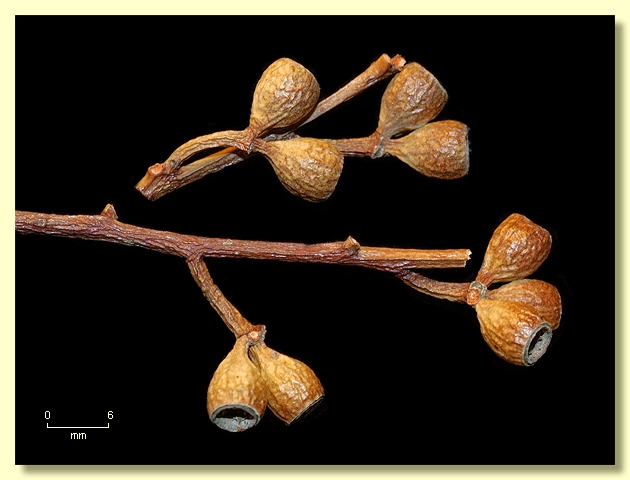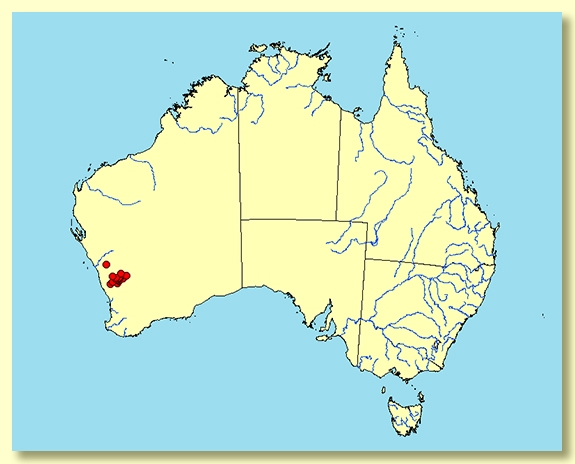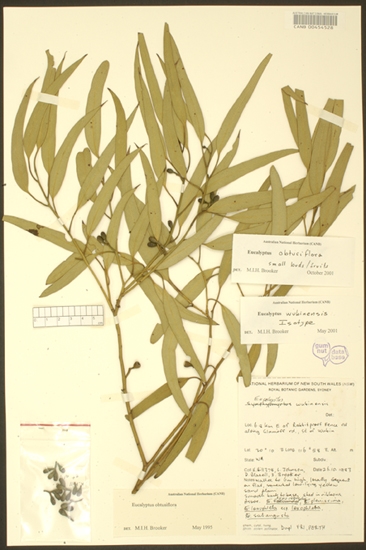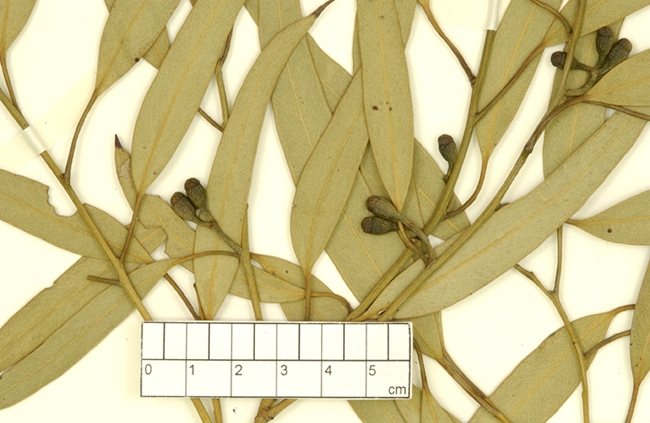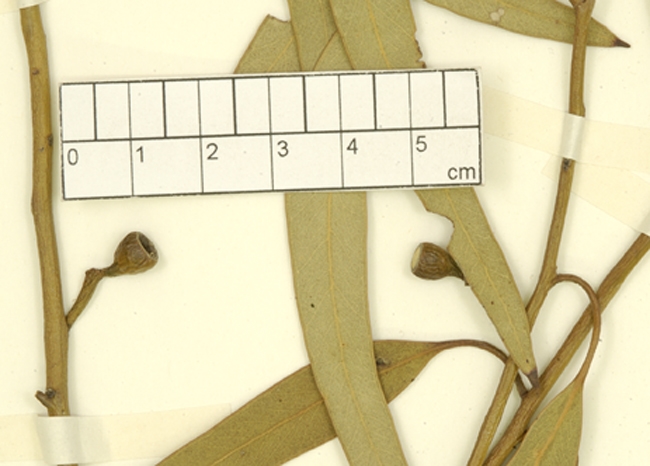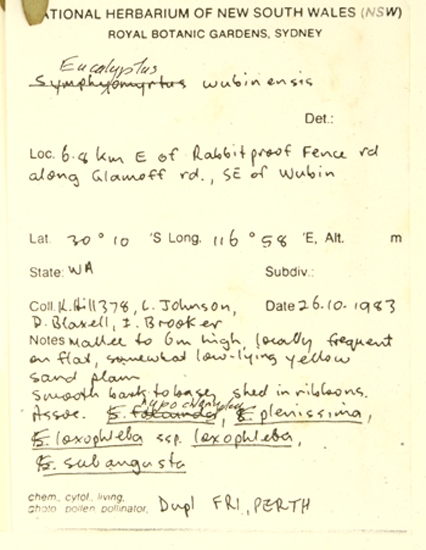Eucalyptus | Symphyomyrtus | Dumaria | Rufispermae
Euclid - Online edition
Eucalyptus wubinensis
Mallee to 8 m tall. Forming a lignotuber.
Bark smooth throughout, light grey to white-grey over tan or pinkish, and cream, shedding seasonally in long ribbons.
Branchlets non-glaucous; brown oil glands present in the pith but may be difficult to find except where leaves arise from stems.
Juvenile growth (coppice or field seedlings to 50 cm): poorly known; the following taken from Hill et al (2001): leaves disjunct [alternate] on stem, petiolate, ovate to orbiculate, to 7 cm long, 4.5 cm wide, glaucous.
Adult leaves alternate, petioles 1–2.2 cm long; blade lanceolate to narrowly so, 7–10(11.8) cm long, 0.8–1.4(2) cm wide, base tapering to petiole, margin entire, apex pointed, dull, mid-green to blue-green or grey-green, concolorous, side veins acute up to about 45° to midrib, reticulation dense, intramarginal vein close to margin, oil glands intersectional.
Inflorescence axillary unbranched, peduncles more or less angular, 0.4–1.5 cm long, buds 7(9) per umbel, pedicellate, pedicels 0.2–0.5 cm long. Mature buds cylindrical to ellipsoid, less commonly ovoid (0.7–0.9 cm long, 0.4–0.5 cm wide), non-glaucous, scar present (outer operculum shed early), inner operculum rounded to slightly flattened and weakly striate, narrower than hypanthium at the join or as wide, stamens regularly inflexed, cuboid to wedge shaped versatile anthers, dorsifixed, dehiscing by longitudinal slits, style long and straight, stigma blunt, locules 4(5), the placentae each with 4 vertical rows of ovules. Flowers not seen.
Fruit pedicellate, pedicels 0.2–0.4 cm long, cupular or shortly barrel-shaped to cylindrical, 0.5–0.8 cm long, 0.5–0.7 cm wide, disc descending obliquely to vertically, valves 4(5), near rim level.
Seeds reddish brown and glossy, 1–2 mm long, flattened-ovoid and sometimes slightly angular in outline, dorsal surface shallowly reticulate, hilum ventral.
Cultivated seedlings (measured at ca node 10): cotyledons reniform; not grown further.
Flowering has been recorded in March.
A tall smooth-barked mallee species endemic to Western Australia where restricted to the wheatbelt between Morowa, Wubin and Wyalkatchem extending east to the south of Lake Moore, and further to Beacon, Wialki and Mukinbudin. It prefers level areas of yellowish sand but in the west of its range can occur on sandy gravelly rises. It is characteriszed by having non-glaucous branchlets, leaves, buds and fruit, the adult leaves usually being dull bluish green, buds small and virtually smooth and with a blunt operculum no wider that the base and often narrower. The fruit are small, smooth, cupular to cylindrical, slightly longer than wide.
Distinguishing E. wubinensis from its closest relatives in series Rufispermae is a bit difficult but the combination of mallee habit, lack of visible wax, dull narrow adult leaves, clearly pedicellate and unridged buds and fruit, and usually sandy habitat will suffice. The following series Rufispermae species will need to be considered. The slender dull-leaved smooth-barked mallet E. vittata occurs in the Goldfields to the east and is almost always conspicuously glaucous but does have non-glaucous forms occasionally, with unridged buds and fruit similar to those of E. wubinensis and clearly the presence or absense of a lignotuber will be important in determining identity. To the west of Wongan Hills and Wubin the mallee E. obtusiflora occurs and it too has waxy and non-waxy forms and often has some basal rough bark, with buds and fruit being slightly longer than those of E. wubinensis but otherwise similar (fruit 0.6-1.2 cm long, 0.6-1 cm wide in E. obtusiflora). To the south of the distribution of E. wubinensis the mallee E. sheathiana occurs and differs in being glaucous on branchlets, buds and young fruit but similar in size of parts. Both E. sheathiana and E. vittata have conical rather than the more or less flattened opercula found in E. wubinensis .
In the classification of Brooker (2000) the more recently published Eucalyptus wubinensis would belong in Eucalyptus subgenus Symphyomyrtus section Dumaria having these features: buds initially with two opercula the outer shed early, stamens strongly inflexed, ovules in 4 rows on the placentae and cotyledons reniform. Within section Dumaria the species belongs to a large sub-group of closely related species (series Rufispermae, 37 described species and subspecies) diagnosed by glandular pith in the branchlets, cuboid to wedge shaped versatile anthers, and by the reddish brown and glossy, flattish seeds which are unique to the series.
Eucalyptus wubinensis: after the town of Wubin in the geographic area of occerrence of the species.


